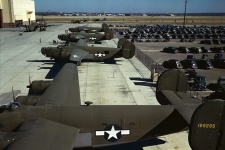
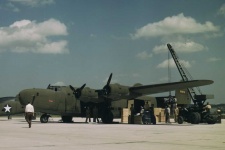
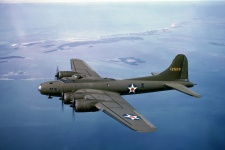
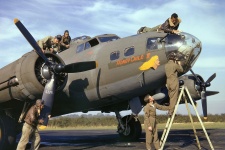
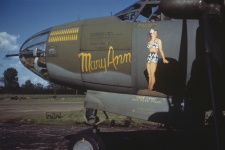
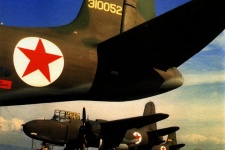
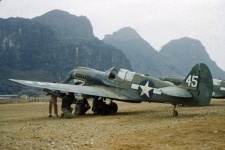
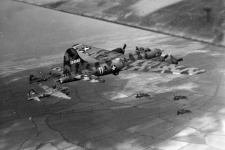
All colors in this page include a paint chart with matches or equivalences from 19 different model paint ranges. Paints are considered matches if they are labeled with the intended color (either uniquely on together with another color). Paints are considered equivalences if they are close to the intended color but not labeled as such. The accuracy of any paint is independent of whether it is a match or an equivalence and these are described in the text (there can be poor matches and highly accurate equivalences). The following nomenclature is used in the paint tables and is based on matches or equivalences to US Insignia Red FS 11136:
| Paint | Match or equivalence type (label) |
| MP01 | Labeled to match one specific color (FS 11136) |
| MP02* | Labeled to match more than one color of same-country standards (FS 11136 / ANA 509)* |
| MP03** | Labeled to match more than one color of different-country standards (FS 11136 / BS 538) |
| MP04 (!) | Questionable accuracy of label match (doesn't look like FS 11136) |
| MP05 (?) | Questionable accuracy of label match, untested (doesn't look like FS 11136 in the bottle) |
| (MP06) | Close equivalent to FS 11136 (BS 538) |
| (MP07) (?) | Questionable equivalent to FS 11136 (Generic Gloss Red) |
* A single asterisk also denotes implicit matches for same-country standards where there is an official succession between standards. For example, H327* would match ANA 509 even if the label only references FS 11136 since ANA 509 is its official predecessor. This does not apply when there are considerable differences between successive paints (ex: Olive Drab No. 41/ANA 613/FS 34087) and this will be described in the text. By and large, however, single asterisk matches should be considered close enough to unique matches as to not be seriously questioned.
The paint charts make no distinction between gloss, semi-gloss, and matt variants of a color if the correct sheen is unavailable (ex: gloss FS 11136 will be a specific match for matt FS 31136 if the latter does not exist in the same paint range). Exceptions are made where there is a known or suspected color difference (ex: FS 24087 and 34087).
At the beginning of World War II, all USAAF combat aircraft were painted with a standard pattern of Dark Olive Drab No. 41 (usually referred to simply as Olive Drab) over Neutral Grey No. 43. Optionally, the otherwise bland pattern could be disrupted with Medium Green No. 42 blotches usually on the edges of wings, vertical stabilizers, and fins and in widely irregular fashion. One of the biggest debates in World War II camouflage is the exact shade of OD 41, particularly since USAAF and Army versions were different, and USAAF versions changed over time, notably when the ANA system was implemented in 1943. It is generally accepted that OD 41 was an olive green when freshly painted but faded towards either a deeper dark green or, more commonly, into a dark tan. The differences in fading were caused by the fact that paint manufacturers used different pigments in order to match the official color chip. It also faded differently on fabric surfaces than on metal, hence why OD 41 aircraft often appeared with lighter flaps and other movable surfaces or in some cases, the reverse. Probably no other color in the history of military camouflage has shown more variety in color photos, and given that all drabs tend to hover close between appearing green or brown, very modest changes in lighting and saturation could also affect its perceived color.
Neutral Grey No. 43 is, thankfully, less controversial, and as the name implies is as close to a perfectly neutral gray as can be (its predecessor, Neutral Gray No. 32 on a 1939 specification had a Munsell value of 5N which under the 1929 notation meant a perfect neutral). It can also appear warmer or cooler depending on the photo, and also tended to look darker than it was due to the inevitable dirtying of the undersides. Medium Green No. 42 superseded the earlier Sea Green No. 28, moving towards a deeper green but still retaining a blueish hue. Although the intended effect of blotches was to disrupt the edges of aircraft, in practice it tended to fade much less than OD 41 and thus made the edges of aircraft stand out considerably more, particularly in black and white photos.
On 15 June 1943, Technical Order T.O. 07-1-1 specified various special and temporary finishes on USAAF aircraft that differed from the standard scheme. These involved replacing OD 41 for MG 42 on aircraft operating in predominatly green terrain and OD 41 for Sand No. 49 over desert terrain (see Mediterranean Theater section). NG 43 could also be replaced by Black No. 44 undersides for aircraft used at night. The Order also allowed the older colors from Specification 14057-C in place of the current ones. These were Sea Green No. 28 for MG 42, Sand No. 26 for Sand 49, and Black No. 33 for Black No. 44. A small number of USAAF bombers based in England in the summer of 1942 may have used MG 42 topsides but otherwise these special finishes were rare.
The following table shows the main colors used in the general and special schemes.
| Special | Temporary | ||
| Upper | Lower | Upper | Lower |
| Green | |||
| MG 42 | NG 43 | SG 28 | NG 43 |
| Desert | |||
| Sand 49 | NG 43 | Sand 26 | NG 43 |
| Night | |||
| OD 41 | Black 44 | OD 41 | Black 33 |
On 28 September 1943, the ANA system was implemented which superseded the older Bulletin No. 41 paints with new ANA equivalents (see Late War section). However, it is well known that most new USAAF aircraft would continue to be painted in OD 41 and NG 43 while existing stocks lasted, and these would have lasted even further in light that aircraft were ordered to be left unpainted barely a month after the ANA system came into force. Adding to the confusion is the fact that, briefly before the implementation of the ANA system, authorities temporarily switched to the so-called Olive Drab 319 which was a color used by the US Army Corps of Engineers and is also different from both OD 41 and ANA 613, being a slightly lighter brown. Despite being an Army color, it was likely used on a small number of aircraft in 1943.
Paint guide:
| No. 43 | No. 41 | No. 42 | |
| Neutral Gray | Dark Olive Drab | Medium Green | |
| Scheme | |||
| General | Lower | Upper | Blotches |
| Paints | |||
| Gunze Aqueous | H53 | (H78) | (H302) |
| Gunze Mr. Color | C13 | (C38) | (C302) |
| Humbrol | 176 | (66) | (149) |
| Model Master | (2035) | - | (1764) |
| Revell | (374) | - | (48) |
| Tamiya | XF-53 | XF-62 | (XF-26) |
| Vallejo Model Air | 71.051* | 71.316 | (71.124) |
| Vallejo Model Color | (70.992) | - | (70.895) |
| AKAN | 72038 | - | (72037) |
| AK Interactive | AK 2203 | AK 2201 | AK 2202 |
| AK Real Colors | RC261 | RC259 | RC260 |
| AMMO by Mig | A.MIG-239* | A.MIG-237* | (A.MIG-238) |
| Colourcoats | ACUS13* | ACUS15 | ACUS16 |
| Hataka | HTK-_033 | HTK-_004 | HTK-_019 |
| Lifecolor | UA 046* | UA 005* | UA 008* |
| Mission Models | - | MMP-091 | (MMP-028) |
| Mr. Paint | MRP-141 | MRP-139 | MRP-140 |
| Xtracolor | (X158) | - | (X114) |
| Xtracrylix | (XA1158) | - | (XA1114) |
 | These B-24Hs at Consolidated's Fort Worth plant show freshly painted OD 41 over NG 43. The photo is likely sometime around mid-1943, making them among the last B-24s that were built painted. |
 | Another look at fresh OD 41 on a C-87, the transport version of the Liberator. This is about as green as it can appear in color photos. |
 | Possibly the best photo of a wartime B-17 in terms of color balance. The greenish tone of OD 41 is easier to appreciate. Also note how OD 41 faded more in fabric surfaces like the flaps and rudder which is also evident in the factory photos. |
 | The faded aspect of OD 41 on the fuselage of this B-17 is evident when compared with the freshly painted bit in the nose art. Faded OD 41 was considerably browner. |
 | This close up of the nose of a B-26 also shows the browner look on many aircraft in the field. It is rare to see this shade on factory photos. |
 | These are new US-based A-20s awaiting transfer to the USSR. The MG 42 blotches are clearly evident on the fins. |
 | This picture of a China-based P-40 being loaded for a rocket mission shows a much better color balance of MG 42 (or possibly ANA 612?) blotches on OD 41. |
 | There was no consistent pattern of MG 42 when applied. Although in the majority of cases they were blotches, in some cases they covered much more than just the edges due to concerns over Luftwaffe air attacks against UK bases in 1942-43. The other aircraft appear to have fullMG 42 topsides as they have not faded as much as the OD 41. |
This was a variant of the basic early war scheme, and consisted of using Insignia White No. 46 undersides rather than Neutral Gray No. 43. IW 46 is off-white (or 'tinted' white) with a slight sepia-like tone. However, most photographs will be indistinghishable from a basic white, particularly at a distance. The Sea Seach scheme retained Olive Drab No. 41 as the topside color and when applicable, Medium Green No. 42 blotches. In contrast to the basic scheme, the demarcation point was higher on the fuselage sides (around halfway) in very pronounced waves, and the IW 46 would also extend into the fins resulting in a very simple but elegant camouflage pattern. This scheme was only applied on USAAF aircraft on anti-submarine duties.
Paint guide:
| No. 46 | No. 41 | No. 42 | |
| Insignia White | Dark Olive Drab | Medium Green | |
| Scheme | |||
| Sea Search | Lower | Upper | Blotches |
| Color Matches | |||
| Gunze Aqueous | H316* | (H78) | (H302) |
| Gunze Mr. Color | C316* | (C38) | (C302) |
| Humbrol | - | (66) | (149) |
| Model Master | 1745* | - | (1764) |
| Revell | - | - | (48) |
| Tamiya | - | XF-62 | (XF-26) |
| Vallejo Model Air | 71.279* | 71.316 | (71.124) |
| Vallejo Model Color | (70.820) | - | (70.895) |
| AKAN | (73146) | - | (72037) |
| AK Interactive | AK 2052* | AK 2201 | AK 2202 |
| AK Real Colors | RC222* | RC259 | RC260 |
| AMMO by Mig | - | A.MIG-237* | (A.MIG-238) |
| Colourcoats | ACUS10 | ACUS15 | ACUS16 |
| Hataka | HTK-_043* | HTK-_004 | HTK-_019 |
| Lifecolor | UA 148* | UA 005* | UA 008* |
| Mission Models | MMP-104* | MMP-091 | (MMP-028) |
| Mr. Paint | MRP-135* | MRP-139 | MRP-140 |
| Xtracolor | X141* | - | (X114) |
| Xtracrylix | XA1141* | - | (XA1114) |
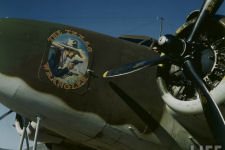 | This B-34 (USAAF version of the Navy's Ventura / Harpoon) shows the attractive contrast between Olive Drab and Insignia White. |
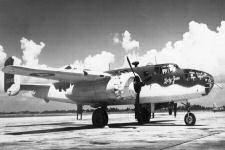 | Note how the Insignia White extended across a larger part of the fuselage and even the fins. |
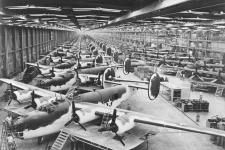 | The B-24 was arguably the best sub-hunter of World War II and these are being painted in Sea Search colors in the factory. |
USAAF aircraft that participated in the North Africa campaign had a bewildering array of camouflage patterns, using both US colors as well as approximations of RAF desert camouflage. The basic desert camouflage scheme was initially Sand No. 26 over Neutral Gray No. 43. Sand 26 was part of the older Specification 14057-C from 27 December 1939 and would have still been in use given that Air Corps Bulletin No. 41 did not include an equivalent Sand color. This changed on 1 October 1942 when Sand No. 49 was added the palette in Bulletin No. 41-A. The two Sands were noticeably different. Sand 26 was lighter and had a flesh-like hue. Both colors are closer to desert pinks than sand, but the few color photos available suggest that they faded into a more tan-like color. Aircraft participating in the Torch landings were almost certainly using Sand 26. Sand 49 probably found its way into combat aircraft late in the North African campaign, probably during the fighting in Tunisia as well as the fighting that followed in Sicily and southern Italy. The introduction of the ANA system in September 1943 resulted in Sand 49 being succeeded by Sand ANA 616. Lighter than Sand 49 (though not as much as No 26), it was noticeably less pink, being matched to post-war FS 30279. It is unlikely that it was used in anything more than a handful of aircraft (if at all) given that by then the fighting was moving into more temprate regions and most USAAF aircraft were being left in natural metal anyway.
USAAF aircraft were also known to carry a three-tone scheme which usually consisted of Dark Olive Drab No. 41 and Sand 26/49 over NG 43 in a pattern remniscient of RAF camouflage. RAF camouflage schemes were also known to be used on USAAF aircraft these being US equivalents or possibly field repaints from RAF stocks. Although Sand is most closely associated with the MTO, it was also used on some aircraft in the Pacific during the New Guinea campaign such as the P-40s of the 15th Fighter Group. However, it is believed that this was a completely different type of paint, being considerably lighter and intended to conceal aircraft against the white sands of the South Pacific. Undersides were probably white, although photographic evidence suggests that much more of the fuselage was painted sand relative to the normal demarcations. Some photos show NG 43 wheel caps which are further suggestive of the ad hoc nature of this scheme.
The Northwest African Air Forces (NAAF) sported temporary special schemes from March 1943 which are described in the following section.
Paint guide:
| No. 43 | No. 26 | No. 49 | ANA 616 | No. 41 | |
| Neutral Gray | Sand | Sand | Sand | Dark Olive Drab | |
| Schemes | |||||
| Desert | Lower | Upper / (Upper Camo) | (Upper Camo) | ||
| Desert (Oct 42) | Lower | Upper / (Upper Camo) | (Upper Camo) | ||
| Desert (Sep 43) | Lower | Upper / (Upper Camo) | (Upper Camo) | ||
| Color matches | |||||
| Gunze Aqueous | H53 | (H44) (?) | - | - | (H78) |
| Gunze Mr. Color | C13 | (C51) (?) | - | - | (C38) |
| Humbrol | 176 | (61) (?) | - | (250) | (66) |
| Model Master | (2035) | (2001) (?) | - | 2053 | - |
| Revell | (374) | (35) (?) | - | - | - |
| Tamiya | XF-53 | (XF-15) (?) | - | - | XF-62 |
| Vallejo Model Air | 71.051* | - | - | 71.140* | 71.316 |
| Vallejo Model Color | (70.992) | 70.804** | (70.804) | - | - |
| AKAN | 72038 | - | - | - | - |
| AK Interactive | AK 2203 | (AK 3012) (?) | - | (AK 2111) | AK 2201 |
| AK Real Colors | RC261 | - | - | (RC032) | RC259 |
| AMMO by Mig | A.MIG-239* | (A.MIG-116) (?) | - | - | A.MIG-237* |
| Colourcoats | ACUS13* | - | (ACRN16) | - | ACUS15 |
| Hataka | HTK-_033 | - | - | (HTK-_068) | HTK-_004 |
| Lifecolor | UA 046* | (UA 709) (?) | UA 089* | (UA 089) | UA 005* |
| Mission Models | - | - | - | - | MMP-091 |
| Mr. Paint | MRP-141 | - | (MRP-185) | MRP-144 | MRP-139 |
| Xtracolor | (X158) | (X406) (?) | (X032) | - | - |
| Xtracrylix | (XA1158) | - | (X1032) | - | - |
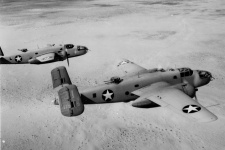 | The B-25s of the 12th Bombardment Group were among the first USAAF aircraft to see combat in North Africa, in August 1942. Here they show how their Sand 26 topsides blend with the terrain. |
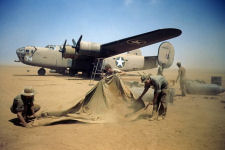 | A B-24 in Sand over NG camo. Aircraft in the MTO were very dusty and faded quickly in the scorching sun. However, at least the forward fuselage here appears clean which may suggest a recently arrived aircraft, given the Torch landings-era insignia. |
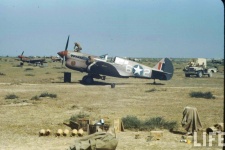 | The P-40s of the 57th Fighter Group were pictured in color by Life Magazine. This photo has been resaturated by a third to show the pinkish hue of Sand 26 (or 49). |
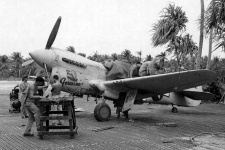 | The well-known P-40N 'Geronimo' of the 15th Fighter Group shows the special sand color used on some Pacific aircraft. It would have blended well with the sand from above. Note the wheel caps which are most likely NG 43. |
On 10 March 1943 a new order was given for the HQ Northwest African Air Forces introducing a number of new camouflage schemes using Army Corps of Engineers colors. It is believed that this responded to the beefed up Luftwaffe presence in Tunisia and its success in attacking US airbases during the Battle of the Kasserine Pass. The order called for a general topside camouflage scheme of Field Drab No. 303 and Olive Drab No. 319 (only if the aircraft was not painted in OD 41 already). FD 303 was similar to RAF Dark Earth and said to approximate FS 30118. OD 319 was somewhat in between OD 41 and the later ANA 613, resembling a dark olive brown. It does not match well with any FS color, the closest approximation being a darker and greener FS 34088. Undersides in the general scheme were a mix of Light Blue No. 307 and white in a 1:8 ratio.
The order also gave a number of special schemes to be used depending on the terrain type where the aircraft was based, these being red, yellow, green, and light sand, the latter having two versions depending on whether the terrain was all sand or spotted. These special schemes incorporated numerous other colors, mostly earthly tones, from the USACE palette. These additional colors along with their approximate FS numbers are Earth Brown No. 302 (FS 30099), Earth Red (FS 30117), Earth Yellow No. 312 (FS 30257), Sand No. 306 (FS 33448), and Light Green No. 321 (FS 34258). The order also provided various color drawings for the major combat aircraft types in use. However, the schemes defined for each aircraft type differed from those proposed under the general and special schemes. It is unclear (to me) whether these were intended to be the basic colors used for each aircraft or merely examples; the photos appear more consistent with the former especially since the basic scheme of FD 303/OD 319 would be nearly indistinguishable. In the event, it is believed that only A-20, B-25, and P-40 aircraft ever sported them, and in some cases like A-20, in widely different patterns.
The following table shows the main colors used in the general and special schemes.
| Upper | Lower | |
| General | ||
| FD 303 | OD 319 | LB/W (1:8) |
| Red | ||
| EY/ER (1:1) | EB 302 | LB/W (1:8) |
| Yellow | ||
| EY/FD (2:1) | EB 302 | LB/W (1:8) |
| Green | ||
| LG 321 | OD 319 | LB/W (1:8) |
| Light Sand | ||
| Sand 306 | Sand 306 | LB/W (1:8) |
| Light Sand (Spotted) | ||
| Sand 306 | FD 303 | LB/W (1:8) |
The following table shows the main colors used across the different aircraft types according to the color drawings. These were notable for including non-USACE colors.
| Upper | Lower | |
| A-20 | ||
| Sand 306 | OD 41 | NG 43 |
| B-17 | ||
| Sand 306 | OD 41 | NG 43 |
| B-24 | ||
| Sand 49 | OD 319 | LB/W (1:8) |
| B-25 | ||
| Sand 49 | OD 319 | NG 43 |
| P-38 | ||
| Sand 49 | OD 319 | LB/W (1:8) |
| P-40 | ||
| EY/ER (1:1) | EB 302 | LB/W (1:8) |
Paint guide:
| No. 306 | No. 319 | |
| Sand | Olive Drab | |
| Schemes | ||
| NAAF (Mar 43) | (Upper Camo) | (Upper Camo) |
| Color matches | ||
| Gunze Aqueous | - | - |
| Gunze Mr. Color | - | - |
| Humbrol | - | - |
| Model Master | (2136) (?) | - |
| Revell | - | - |
| Tamiya | - | - |
| Vallejo Model Air | (71.122) (?) | - |
| Vallejo Model Color | - | - |
| AKAN | - | - |
| AK Interactive | (AK 122) (?) | - |
| AK Real Colors | (RC079) (?) | - |
| AMMO by Mig | (A.MIG-025) (?) | - |
| Colourcoats | (ARUS01) | ARUS03 |
| Hataka | - | - |
| Lifecolor | (UA 107) | UA 220 |
| Mission Models | (MMP-039) (?) | MMP-024 |
| Mr. Paint | (MRP-80) (?) | - |
| Xtracolor | (X812) (?) | - |
| Xtracrylix | (XA1812) (?) | - |
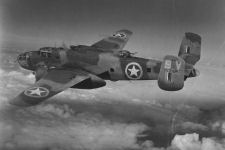 | This B-25 still carries the Torch-style national insignia but the camouflage pattern is suggestive of the NAAF scheme (OD 319/Sand 49). |
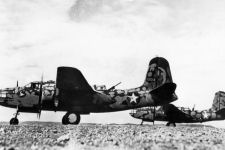 | These A-20s of the 47th Bombardment Group used completely unique patterns that did not match the type-specific guidelines but most likely used the colors (OD 41/Sand 306). |
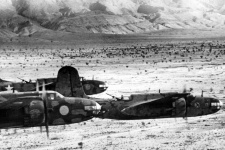 | Another good photo of the wild A-20 camouflage during this period. |
The United States adopted a joint USAAF/USN color system on 28 September 1943 with the publication of the Army-Navy Aeronautical Bulletin 157, this new system is popularly known as ANA. Almost all existing colors were replaced by their ANA versions, usually with some variation from their earlier version. Olive Drab ANA 613 was considerably different from its predecessor, Olive Drab 41, being slightly lighter and more brown. Neutral Gray 43 was abandoned altogether, it's replacement was a US approximation of RAF Ocean Grey known as Sea Gray ANA 603 which was considerably darker and with a hint of blue although far less than its post-war successor, FS 36118. Medium Green 42 also had a new equivalent in Medium Green ANA 612 which of the three colors was most similar to its predecessor but moving closer to a green-gray than a sea green. As mentioned earlier, both OD 41 and NG 43 continued to be used while stocks lasted which meant that most aircraft in the OD / NG scheme retained their older colors. However, a major change curred on 30 October 1943 when it was ordered to abandoned factory camouflage altogether, with all combat aircraft built from then retaining their natural metal finish (NMF) and existing planes having their paint removed during repairs or overhauls. The order was formalized in a revision to T.O. 07-1-1 on 26 December 1943. Olive Drab (or Medium Green) was retained as the color for anti-glare panels on unpainted aircraft. Exceptions to the rule were night fighters and transport aircraft, A-20 attack aircraft, as well as A-20, A-26, and B-25 aircraft used by the Far East Air Force (FEAF). A 3 March 1945 order (TI-2094 Add. No. 2) specified that those FAEF aircraft that retained camouflage were to use ANA 613/603 which means they are the only aircraft known to have definitively used the new colors, though sadly no color photographs exist.
Despite the new factory orders, field commanders were allowed to camouflage their aircraft at their discretion, which resulted in many aircraft retaining one or both of OD/NG. One common pattern was OD applied unevenly to the upper surfaces while the lower fuselage and sides were left in NMF, as was the case of the P-51s of the 361st Fighter Group. If stocks of OD were not available at UK airfields, then RAF Dark Green was used instead. Some units even discarded OD/NG altogether like the P-47s of the 56th Fighter Group whose 61st Squadron was painted in matt black (which faded to a dark blue or purple) over NMF, while its 63rd Squadron was painted in a pattern of indigo blue and sky blue over NMF. None of these were official US colors. Others in this group used the RAF Day Fighter Scheme of Ocean Grey / Dark Green with Medium Sea Grey undersides. The P-47s of the 78th Fighter Group was also known for its Dark Green topsides and Sky undersides.
From June 1944, D-Day invasion stripes were applied to nearly all Allied aircraft which participated in the landings. These consisted of three white stripes with two black stripes in between, all 18-inch in size for single-engine aircraft and 24-inch for twin-engined aircraft, and were placed in both the upper and lower wings as well as around the rear fuselage. The topside stripes were the first to be removed in the weeks after the invasion although underside fuselage and wing strips were still seen throughout the remainder of the year.
By and large, by this point in the war the Allies enjoyed air superiority to such an extent that camouflage became irrelevant, as evidenced by the gradually more colorful and flamboyant squadron markings seen on USAAF aircraft in 1944-45. Photographic evidence of aircraft unmistakably using ANA 613/603 remains elusive.
Paint guide:
| ANA 603 | ANA 613 | ANA 612 | ||
| Sea Gray | Olive Drab | Medium Green | Aluminum | |
| Schemes | ||||
| Basic | Lower | Upper | Blotches | |
| Basic (Oct 43) | Anti-glare | Overall | ||
| Color matches | ||||
| Gunze Aqueous | - | H52 | (H302) | (H8) |
| Gunze Mr. Color | - | C12 | (C302) | (C8) |
| Humbrol | (125) | (155) | (149) | 56 |
| Model Master | (1723) | 2050 | (1764) | 1781 |
| Revell | (74) | - | (48) | 99 |
| Tamiya | (XF-24) | - | (XF-26) | XF-16 |
| Vallejo Model Air | 71.097* | 71.016* | 71.124* | 71.062 |
| Vallejo Model Color | (70.868) | 70.887* | (70.895) | - |
| AKAN | 72040* | 72033 | 72037 | 76004 |
| AK Interactive | (AK 2144) | AK 2204 | (AK 2106) | - |
| AK Real Colors | (RC244) | - | (RC230) | RC020 |
| AMMO by Mig | (A.MIG-204) | A.MIG-240* | A.MIG-238 | A.MIG-194 |
| Colourcoats | (ACUS14) | - | (ACUS16) | - |
| Hataka | HTK-_031* | HTK-_018 | (HTK-_019) | HTK-_078 |
| Lifecolor | (UA 022) | - | (UA 008) | LC-74 |
| Mission Models | (MMP-084) | - | - | MMM-003 |
| Mr. Paint | (MRP-40) | MRP-138 | MRP-235* | MRP-3 |
| Xtracolor | (X130) | X113 | (X114) | X142 |
| Xtracrylix | (XA130) | XA1113 | (XA1114) | (XA1216) |
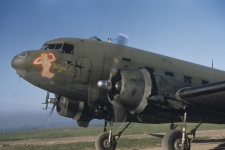 | If there is any candidate for an ANA 613 / ANA 603 color photo it might be this C-47, the personal aircraft of Lt. Gen. Lewis H. Brereton. The caption references a trip to the (French?) Riviera which would only be possible in late 1944 or 1945. The jury is still out and OG 41 / NG 43 should be assumed otherwise. |
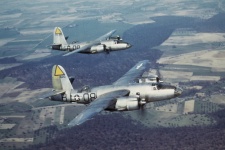 | By the second half of 1944, most USAAF aircraft would be seen in full or partial natural metal finish like this pair of B-26s with dulled out but still visible D-Day invasion stripes. The foreground aircraft still has Olive Drab rudders. |
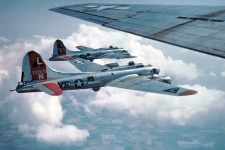 | This flight of B-17s in natural metal show the angled Olive Drab anti-glare panels on the engines, aside from the one in front of the cockpit. |
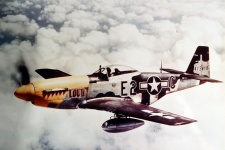 | The famous 'Lou IV' of the 361st Fighter Group showing its OD/NMF scheme which some claim is RAF Dark Green. Contrary to a myth that refuses to die, there is no evidence to suggest this aircraft was ever painted bright blue as it is sometimes shown. |
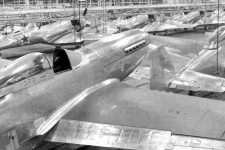 | The P-51's laminar flow wing was overpainted in aluminum lacquer giving it a dulled out appearance. This would have been less evident in the field as the shinier fuselage got worn out. |
The USAAF began equipping with night fighters like the P-61 as well as converted versions of the P-38 and A-20 (known as P-70) in the second half of the war. These were finished in the typical scheme of Olive Drab No. 41/ANA 613 over Neutral Gray No. 43/ANA 603 which was maintained even after the 30 October 1943 order of leaving most combat aircraft unpainted at the factory. Later, experiments were undertaken to provide a suitable gloss black paint for night operations which resulted in Jet ANA 622, which was only added to the ANA system on 26 April 1944 although it began to be used in January of that year. Despite being gloss, it was often applied without a primer (notably by Northrop which built the P-61) and tended to both fade and look matt after extensive use. It was not uncommon for many P-61s to paint their radomes Insignia White No. 46/ANA 601 and being of a different material than the fuselage, frequently showed different patterns of fading.
Paint guide:
| ANA 601 | ANA 603 | ANA 613 | ANA 622 | |
| Insignia White | Sea Gray | Olive Drab | Jet | |
| Schemes | ||||
| Basic | (Radome) | Lower | Upper | |
| Black | (Radome) | Overall | ||
| Color matches | ||||
| Gunze Aqueous | (H316) | - | H52 | (H2) |
| Gunze Mr. Color | (C316) | - | C12 | (C2) |
| Humbrol | (22) | (125) | (155) | (21) |
| Model Master | (1745) | (1723) | 2050 | (1747) |
| Revell | (04) | (74) | - | (08) |
| Tamiya | (X-2) | (XF-24) | - | (X-1) |
| Vallejo Model Air | 71.279* | 71.097* | 71.016* | (71.057) |
| Vallejo Model Color | (70.820) | (70.868) | 70.887* | (70.861) |
| AKAN | (73146) | 72040* | 72033 | (78005) |
| AK Interactive | (AK 2052) | (AK 2144) | AK 2204 | (AK 719) |
| AK Real Colors | (RC222) | (RC244) | - | (RC001) |
| AMMO by Mig | (A.MIG-047) | (A.MIG-204) | A.MIG-240* | (A.MIG-032) |
| Colourcoats | ACUS37 | (ACUS14) | - | |
| Hataka | HTK-_043* | HTK-_031* | HTK-_018 | (HTK-_041) |
| Lifecolor | (LC 51) | (UA 022) | - | (LC 01) |
| Mission Models | (MMP-104) | (MMP-084) | - | (MMP-047) |
| Mr. Paint | MRP-135 | (MRP-40) | MRP-138 | MRP-137 |
| Xtracolor | (X141) | (X130) | X113 | (X012) |
| Xtracrylix | (XA1141) | (XA130) | XA1113 | (XA1012) |
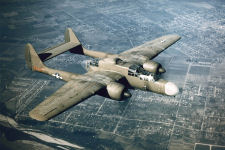 | A P-61 in OD/NG probably in late 1943 or early 1944. Note the IW radome. |
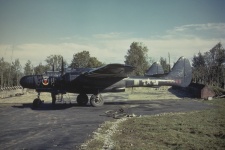 | Another UK-based P-61 showing the glossy sheen of ANA 622, at least when relatively fresh. |
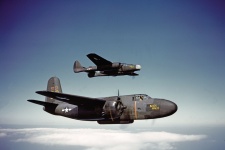 | A P-70 and P-61 in ANA 622. The gloss sheen has all but disappeared. |
Shortly after the US entry into the war, the USAAF was approached by a Boston paint manufacturer known as Samuel Cabot with a proposal for a new white Haze paint that allegedly rendered aircraft close to invisible by means of the Tyndall Effect, the same light scattering effect that causes skies to appear blue. The effect on aircraft was achieved by using a black base and then spraying the haze paint in layers, building it up to produce sections of the aircraft that were lighter (such as the undersides) resulting in a mottled appearance. The USAAF was impressed and eventually adopted it on its F-4 and early F-5 Lightnings (photo-reconnaissance version of the P-38) from March 1942. Unfortunately, Haze tended to darken considerably in use, was extremely time-consuming to apply, and could not be applied at night either. As a result it was briefly discontinued between October and January of the following year. However, a revised version referred to as Synthetic Haze was developed shortly thereafter by Lockheed. Unlike the original, it was applied on a dark sky blue base and was also applied more uniformly giving the appearance of a single color. This became the standard color on the later F-5 Lightnings from March 1943. The closest equivalents to the intended color (known as 'Flight Blue') is FS 35190 and, to a lesser extent, ANA 501 (Light Blue). Given the brighter base color, it it likely that Synthetic Haze had a deeper appearance than its Haze predecessor.
Given that the new Synthetic Haze paint did not fully resolve some of the problems of the original in terms of its complex application, from around 1944 most USAAF photo-recon aircraft began painting their aircraft identically to their RAF counterparts using PRU Blue. This is a darker blue-gray compared to Synthetic Haze and would have been applied as a single color. The USAAF was also a major user of British photo-recon aircraft through Reverse Lend-Lease and these included PR versions of Spitfires and Mosquitoes which would have been factory-painted as such. It is likely that the switch to PRU Blue occurred mostly in Europe and the Mediterranean or in regions where there were available stocks of RAF paint.
Paint guide:
| BS 636 | ||
| Flight Blue | PRU Blue | |
| Schemes | ||
| 1942-43 | Overall | |
| 1944-45 | Overall | |
| Color matches | ||
| Gunze Aqueous | - | - |
| Gunze Mr. Color | - | - |
| Humbrol | - | 230 |
| Model Master | - | 2061 |
| Revell | - | - |
| Tamiya | - | - |
| Vallejo Model Air | - | 71.109** |
| Vallejo Model Color | (70.901) | - |
| AKAN | (72076) | - |
| AK Interactive | - | - |
| AK Real Colors | (RC236) | RC297 |
| AMMO by Mig | - | - |
| Colourcoats | ACRN14 | |
| Hataka | - | HTK-_042 |
| Lifecolor | - | - |
| Mission Models | - | - |
| Mr. Paint | (MRP-239) | MRP-120 |
| Xtracolor | X160* | X008 |
| Xtracrylix | - | XA1008 |
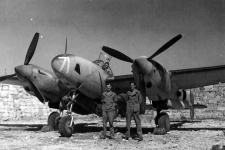 | Despite the lack of color photos, this F-5A in North Africa shows the original Haze pattern with considerable whitening on the sides and underside. |
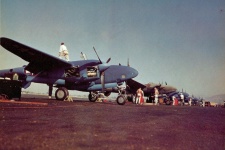 | This line of F-5s are painted in the later Synthetic Haze, which shows more uniformity but the lighter sky blue undersides are evident. |
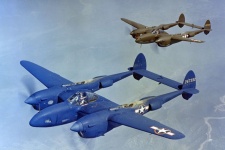 | The best photo of what freshly painted Synthetic Haze looked like. Despite the uniformity of the color, other photos of this same aircraft definitely show lighter sections of the underside. |
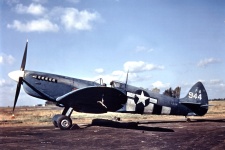 | This excellent photo of a Spitfire PR.IX in USAAF service shows the PRU Blue that became the standard color in 1944, at least in Europe. Strangely, the lower nose looks like a lighter color. |
Upon the entry of the US into World War II, many USAAF aircraft were painted in approximations of RAF camouflage schemes. These included equivalents to the Temperate Land Scheme (Dark Earth/Dark Green) over Sky or the Desert Scheme (Middle Stone/Dark Earth) over Azure Blue. The aircraft most commonly associated with these patterns is the P-40, which was the main US fighter in service at the time of Pearl Harbor and which had already seen combat in the hands of the American Volunteer Group (the 'Flying Tigers') in China where they wore TLS colors. Many aircraft intended for lend-lease were also painted in RAF schemes only to be taken over by the USAAF after Pearl Harbor. It was also the case that many UK-based USAAF aircraft used actual RAF paints, most famously some units based at RAF Duxford (DG over Sky) and RAF Boxted (OG/DG over MSG). There was usually no attempt to replicate RAF patterns and as a result, USAAF patterns varied significantly between aircraft and could be highly irregular.
US equivalent paints initially followed DuPont standards intended to match RAF paints. Of the Temperate Land Scheme colors of Dark Earth (71-009) and Dark Green (71-013), the former was noticeably lighter although the latter was very close. They best match FS 30219 and FS 34096 respectively although FS 34079 has been suggested for Dark Green as well (it is very similar). Confusingly, a second variant of Dark Earth (71-035) came in use later and this was much darker, being closer to the RAF color and also fading less. It closely matches FS 30118. In contrast, Sky (71-021) has been a source of controversy. Although the DuPont standard closely resembles the RAF original, it is noticeably lighter and is closest to FS 35670 which is not a military color. The next nearest would be FS 35622 which happens to be known as a 'Duck Egg Blue' but is even lighter still. In color photographs, however, it frequently ends up resembling different types of gray, often a light tan grey (closest to FS 36622) as well as a sky gray which could reflect attempts to match Sky Grey rather than Sky Type S. To what extent this reflects an actually different paint shades or simply different color characteristics of the photo is up to debate: most color photos of US versions of Sky are in factory-fresh aircraft whereas most photos of RAF Sky are of aircraft in the field and thus dirtier. Furthermore, factory-fresh photos of RAF Sky are often of early Hurricanes and Spitfires which may have been painted Sky Blue, which in black and white appears lighter and would contrast more sharply with the topside colors just as the DuPont colors do.
As for the Desert Scheme, Middle Stone (71-069) was similar in brightness thus probably looking identical in black and white but lacked the mustard tone of its MAP counterpart. It is closest to FS 30266. When paired with the later Dark Earth (71-035) it would have had much greater contrast than the RAF originals or with 71-009. In contrast, Azure Blue (71-062) was very close to the RAF version aside from being a bit darker and has been matched with FS 35231.
Once the newer ANA colors were developed, US factories were ordered to use designated ANA equivalents instead of DuPont matches. In many cases, these varied significantly from their RAF colors. Although some colors like Dark Earth (71-035), Middle Stone, Sky, and Azure Blue received their own ANA successors, the colors used in the Day Fighter and Temperate Sea Scheme did not. Instead, both schemes used the same equivalents for their greens and grays, these being Olive Drab 613 (closest to FS 34088) and Sea Grey 603 (closest to FS 36118) respectively. While they were close enough to the TSS, they were far less of a match to the DFS: Olive Drab was too dark and too brown and Sea Grey was also too dark and lacked Ocean Grey's distinctive blue tint. Additonally, the US equivalent to Medium Sea Grey was ANA 602 Light Grey. This is often matched to FS 36440 but it is believed that it was somewhat darker but still unsuitable as an equivalent to Medium Sea Grey and was said to have been discontinued shortly after introduced in favor of ANA 621 Dark Gull Gray which was of similar brightness although still somewhat warmer. As with USAAF aircraft, it is likely that stocks of Olive Drab No. 41 were used before switching to ANA 613 which leads to the possibility that only few late-builds ever used it if at all.
A comparison between US and RAF paints is provide below with the disclaimer that Hex equivalents will never be fully accurate to an original paint chip. A more complete listing of all DuPont equivalents to RAF colors as well as additional photos (in RAF markings) is available in the RAF page.
| RAF | US | FS | RAF | US | FS |
| Dark Green (1) | Ocean Grey | ||||
| 71-013 | 34083 | ANA 603 | 36118 | ||
| Dark Earth (1) | Dark Green (2) | ||||
| 71-009 | 30140 | ANA 613 | 34088 | ||
| Dark Earth (2) | Medium Sea Grey (1) | ||||
| 71-035 | 30118 | ANA 602 | 36440 | ||
| Middle Stone | Medium Sea Grey (2) | ||||
| 71-069 | 30266 | ANA 621 | 36231 | ||
| Sky | Sky | ||||
| 71-021 | 35622 | ANA 610 | 34424 | ||
| Azure Blue | Dark Slate Grey | ||||
| 71-062 | 35231 | ANA 613 | 34088 | ||
| Extra Dark Sea Grey | |||||
| ANA 603 | 36118 |
Paint guide: The following paint chart includes only the US equivalents to the Temperate Land (plus Sky) and Desert (plus Azure Blue) schemes as those were the only two to have been used extensively before the ANA equivalent colors were designated. DuPont numbers are in the topmost header row. It should be noted that hardly any paint ranges (Mr. Paint being the sole exception as well as Colourcoats for Sky) carry DuPont/ANA-specific RAF paints, with most merely including them in the labels for convenience. Rather than merely repeat the matches for RAF paints from previous sections, the paint chart takes the closest FS equivalents mentioned in the text in parenthesis under the assumption that modelers will want to make their Lend-Lease models look sufficiently different from home-produced RAF aircraft, the exception being Azure Blue which is virtually identical.
| 71-021 | 71-062 | 71-069 | 71-009 | 71-035 | 71-013 | |
| ANA 610 | ANA 609 | ANA 615 | ANA 617 | |||
| Sky | Azure Blue | Middle Stone | Dark Earth (1) | Dark Earth (2) | Dark Green | |
| Schemes | ||||||
| TLS | Lower | (Upper Camo) | (Upper Camo) | Upper Camo | ||
| Desert | Lower | Upper Camo | (Upper Camo) | (Upper Camo) | ||
| Color matches | ||||||
| Gunze Aqueous | (H314) | - | - | (H310) | - | (H309) |
| Gunze Mr. Color | (C314) | (C370) | - | (C310) | - | (C309) |
| Humbrol | - | (157) | - | (118) | - | (116) |
| Model Master | 2049** / (1722) | 2048** | 2052** | (1742) | 2054** / (1702) | (1710) |
| Revell | - | - | - | - | - | - |
| Tamiya | - | - | (XF-59) (?) | - | - | - |
| Vallejo Model Air | (71.328) | 71.108** | (71.291) | (71.125) | 71.139** | (71.294) |
| Vallejo Model Color | - | 70.902** | (70.977) | (70.874) | (70.873) | (70.893) |
| AKAN | (72074) | (70004) | (6/82044) | (72003) | (6/82045) | (72002) |
| AK Interactive | (AK 2154) | (AK 2017) | - | (AK 2103) | - | (AK 2101) |
| AK Real Colors | (RC241) | (RC291) | (RC030) | (RC225) | (RC085) | (RC027) |
| AMMO by Mig | - | - | - | (A.MIG-202) | - | (A.MIG-206) (?) |
| Colourcoats | ACRN36 | (ACRN34) | - | (ACUS18) | - | (ACUS20) |
| Hataka | HTK-_234* / (HTK-_092) | (HTK-_028) | - | (HTK-_012) | - | (HTK-_016) |
| Lifecolor | (UA 139) | (UA 098) | (UA 081) | (UA 015) | UA 092** | (UA 001) |
| Mission Models | MMP-080** | MMP-092** | - | (MMP-066) | - | (MMP-058) |
| Mr. Paint | (MRP-225) | MRP-143 | (MPR-368) | (MRP-103) | MRP-145 | (MRP-101) |
| Xtracolor | (X149) | (X026) | - | (X102) | (X101) | (X110) |
| Xtracrylix | - | (XA1026) | - | (XA1002) | - | (XA1110) |
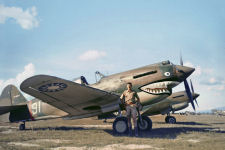 | A P-40 from the Flying Tigers in US Temperate Land Scheme over Sky. Note how DuPont 71-021 differed considerably from RAF Sky in some photos, although the topside camo was closer to their RAF equivalents. |
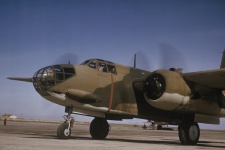 | A quality color shot of an A-20 in US Temperate Land Scheme over Sky, which in this photo also looks more like a light tan gray. The Dark Earth appears to be the older 71-009. |
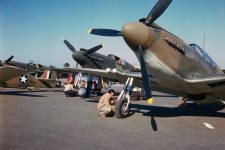 | This excellent photo of early P-51s at North American's Inglewood factory shows a more evident duck egg green tone to the Sky 71-021 and certainly closer to the RAF version. The aircraft in the background is in OG 41. |
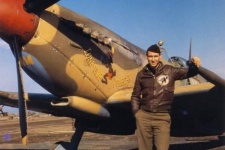 | The USAAF operated Spitfires in the MTO like this Mk VIII. The unconventional demarcation suggests it has been repainted with Desert Scheme / Azure equivalents. |
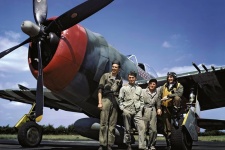 | Francis Gabreski's famous P-47 painted in actual RAF colors from the Day Fighter scheme (Ocean Grey, Dark Green over Medium Sea Grey). The pattern, however, was quite unique. |
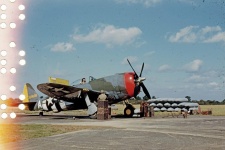 | Another P-47 of the 56th Fighter Group (which else) has a Day Fighter scheme that is closer to the actual RAF pattern. |
The topic of US wartime interiors is highly complicated and in many cases remains speculative to this day. This is because there was considerable leeway with respect to individual manufacturers using their own standards which means that even the same aircraft built in different factories could have different interior colors. For the most part, US aircraft used the same basic corrosion-resistant primer known as Zinc Chromate which also became the default color for exposed interior spaces. The name of this primer referred to the main pigment used rather than the color which was a bright yellow with a greenish hue, hence why it was also referred to as Yellow Zinc Chromate. The exact tone of YZC varied slightly between manufacturers and it was never assigned a number on any color system. A second color was created by adding black enamel pigment to zinc chromate, producing what became known as Green Zinc Chromate (also called Tinted Zinc Chromate). This was used mostly on unexposed interior spaces, cockpits, as well as repainted parts that were previously covered only in YZC. Manufacturers often used different proportions of zinc chromate and lamp black in their mixes and as a result GZC varied even more in practice than YZC. Eventually, a standardized version of GZC was developed by the USN in late 1942 and became known as Interior Green (ANA 611 after the implementation of the ANA system on 28 September 1943). This was slightly darker and browner than the average GZC shade and later superseded by FS 34151 which was even browner still than the wartime shade.
There was much more variety among USAAF aircraft in terms of painting exposed interior spaces. Whereas most USN aircraft used the underside color, the USAAF typically left their wheel wells and covers in either YZC or GZC/IG and in some cases in aluminum lacquer. In many cases they were painted in a combination of these colors, for example, P-51Ds typically had Interior Green wheel wells and aluminum lacquer covers. Landing gear and wheel hubs also tended to be painted in aluminum lacquer although in some cases they were painted in the underside color of Neutral Gray No. 43 before the abandonment of camouflage after 30 October 1943. Other structural spaces such as bomb bays and (non-cockpit) crew compartments similarly varied by aircraft. For example, B-17 bomb bays and cabins were originally painted in GZC/IG but those on the B-24/25/26 were in aluminum lacquer (as were those on the later B-17G). Late-war practices persisted into the post-war period until interior colors became homogenized across all US military branches in 1955.
Paint guide:
| ANA 611 | ||||
| Yellow Zinc Chromate | Green Zinc Chromate | Interior Green | Aluminum | |
| Schemes | ||||
| General | Interiors | Interiors | ||
| General (1943) | Interiors | Interiors | Interiors | |
| Color matches | ||||
| Gunze Aqueous | - | - | H58 | (H8) |
| Gunze Mr. Color | C352 | C351 | C27 | (C8) |
| Humbrol | - | - | 226 | 56 |
| Model Master | - | 1734 | 1715* | 1781 |
| Revell | - | - | - | 99 |
| Tamiya | XF-4** | - | - | XF-16 |
| Vallejo Model Air | 71.107 | 71.094 | 71.137* | 71.062 |
| Vallejo Model Color | - | - | 70.850* | - |
| AKAN | 72034 | - | 72004* | 76004 |
| AK Interactive | AK 2207 | AK 2306 | AK 2303 | - |
| AK Real Colors | RC263 | RC262 | - | RC020 |
| AMMO by Mig | A.MIG-221 | A.MIG-220* (!) | A.MIG-220* | A.MIG-194 |
| Colourcoats | ACUS23 | ACUS22 | ACUS09 | - |
| Hataka | - | - | HTK-_211* | HTK-_078 |
| Lifecolor | - | - | UA 004* | LC-74 |
| Mission Models | MMP-067 | MMP-068 | MMP-059* | MMM-003 |
| Mr. Paint | MRP-129 | - | MRP-131 | MRP-3 |
| Xtracolor | X408 | - | X117* | X142 |
| Xtracrylix | - | - | XA1117* | (XA1216) |
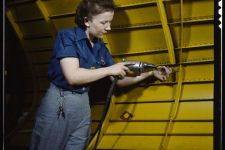 | This real life Rosie the Riveter is working on a fuselage primed in the unmistable yellow tone of untinted Zinc Chromate. |
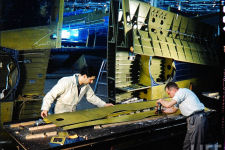 | These workers in a Curtiss plant are surrounded by aircraft parts that are primed in tinted (Green) Zinc Chromate, with some parts showing the untinted version as well. |
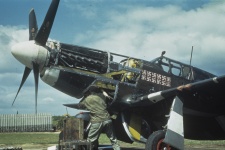 | This P-51B undergoing maintenance shows the plethora of interior colors on USAAF aircraft. |
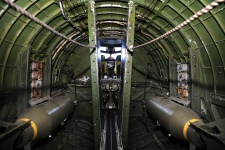 | The bomb bays of this B-17 are painted in Green Zinc Chromate. Late versions would leave most interior areas in aluminum lacquer. |
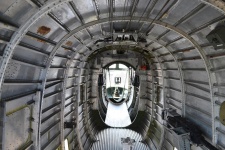 | This is what an aluminum lacquer interior looks like, courtesy of the most widely produced US aircraft of World War II, the B-24. |
US cockpit colors in World War II are the subject of much controversy and speculation. The earliest guidelines for cockpit colors were provided on 9 September 1938 (Specification No. 98-24113-A) which laid out the practice that would be common on many USAAF aircraft and which was based around two colors. The first was Green Zinc Chromate (described in the text as 'Yellow Green') which was to be applied on aircraft with open cockpits or with sliding enclosures such as fighters and other single-engined aircraft. The second color was Bronze Green No. 9 which was to be applied on aircraft with closed cockpits which are part of the fuselage such as bombers and other large multi-engined aircraft. This was introduced as early as November 1919 (US Army Specification No. 3-1) and is a very dark olive green which can be compared to a black-green, although like most cockpit colors it would look considerably lighter in practice.
An ammendment to the specification was made on 6 September 1942 (Amendment No. 6). The guidelines retained Green Zinc Chromate for aircraft with open cockpits or with sliding enclosures. However, a new color known as Dull Dark Green (which had been introduced in USN service in April) replaced Bronze Green for aircraft with closed cockpits. There is considerable speculation regarding its exact color and is generally believed to a darker version of Medium Green No. 42/ANA 612/FS 34092 with more of a blueish hue. More problems arise from the fact that it looks vastly different on many aircraft, in some appearing as a turquoise-like blue-green. The color is much closer to that of actual aged bronze (think of old bronze artifacts and statues) which lends itself to even more confusion with Bronze Green. In late 1942, Green Zinc Chromate was standardized by the USN into the color that would be introduced on 28 September 1943 to the ANA palette as Interior Green ANA 611. This would thereafter become the de facto 'Yellow Green' as previously specified.
A final wartime revision of interior colors was issued on 6 April 1945 (Specification No. 98-24113-B) which had it that all cockpits and other enclosed areas (like turrets as well as bombardier and navigator stations) that were visible were to be painted Medium Green ANA 612 (which I personally suspect was intended to replace Dull Dark Green given its similarity). Areas of cockpits that were reflected in glass were to be painted in Black ANA 604. In practice this meant that the upper half of cockpits (usually from the level above the bottom of the instrument panel) were painted black. Just a few days before the end of the war, on 18 August 1945 an amendment to the previous specification formally established Interior Green ANA 611 as the replacement for 'Yellow Green'. Given the winding down of aircraft production in 1945 it is likely that very few aircraft were ever painted with ANA 612 cockpits.
Unfortunately for the sake of consistency, not all USAAF manufacturers followed the basic guidelines and in many cases created their own proprietary cockpit colors. For example, Curtiss Cockpit Green was developed by local paint vendors and is believed to be a more heavily tinted version of GZC which appeared slightly brown. Northrop Cockpit Green was another such shade, believed to be closer to the typical version of GZC. Early P-38s used Olive Drab cockpits. Finally, there is also some confusion over the colors used by Republic which are thought to be approximations of Bronze Green and (later) Dull Dark Green. Bell Green was a similar dark color, believed to be close to Medium Green. It was common for USAAF aircraft to be built in more than one factory which means more than one cockpit color could have been used.
A summary of the suspected main cockpit colors used on major USAAF aircraft is as follows. All post-war aircraft used Interior Green and Black or overall Black cockpits:
Unlike exterior camouflage, vintage wartime-era color photos of cockpits are a rarity, which makes the problem of approximating the actual colors so much more difficult. Cockpit photos are also notoriously difficult to accurately assess given that colors tend to look lighter than they actually are. Furthermore, restored aircraft like those found in museums may have been repainted and the new color may not match the original. In conclusion, all information here is speculative and should not be taken as the final word on this controversial topic.
Paint guide:
| ANA 611 | ANA 604 | ||||
| Green Zinc Chromate | Bronze Green | Dull Dark Green | Interior Green | Black | |
| Schemes | |||||
| General | (Cockpit) | (Cockpit) | |||
| General (Sep 42) | (Cockpit) | (Cockpit) | |||
| General (Sep 43) | (Cockpit) | (Cockpit) | |||
| General (Apr 45) | Lower cockpit | Upper cockpit | |||
| Post-War (Alt) | Cockpit | ||||
| Color matches | |||||
| Gunze Aqueous | - | - | - | H58 | H12 |
| Gunze Mr. Color | C351 | - | - | C27 | C33 |
| Humbrol | - | (75) | - | 226 | 33 |
| Model Master | 1734 | (2025) | - | 1715* | 1749 |
| Revell | - | (65) | (48) | - | 04 |
| Tamiya | - | - | - | - | XF-1 |
| Vallejo Model Air | 71.094 | 71.250** | - | 71.137* | 71.057 |
| Vallejo Model Color | - | 70.897** | - | 70.850* | 70.950 |
| AKAN | - | (71076) | - | 72004* | 78005 |
| AK Interactive | AK 2306 | AK 2205 | AK 2106* | AK 2303 | AK 735 |
| AK Real Colors | RC262 | RC264 | RC230* | - | RC001 |
| AMMO by Mig | A.MIG-220* (!) | - | A.MIG-077 | A.MIG-220* | A.MIG-046 |
| Colourcoats | ACUS22 | ACUS30 | ACUS24 | ACUS09 | C02 |
| Hataka | - | - | - | HTK-_211* | HTK-041 |
| Lifecolor | - | (UA 111) | - | UA 004* | LC 02 |
| Mission Models | MMP-068 | - | - | MMP-059* | MMP-047 |
| Mr. Paint | - | MRP-132 | MRP-229 | MRP-131 | MRP-171 |
| Xtracolor | - | - | - | X117* | X012 |
| Xtracrylix | - | - | - | XA1117* | XA1012 |
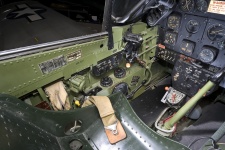 | The legendary P-51D Mustang shows a classic Interior Green cockpit. It was common for Mustang seats (outsourced to a supplier) to be painted Bronze Green or Dull Dark Green. |
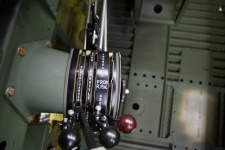 | Definitive color photos of Bronze Green are rare. This is a Razorback P-47 under restoration at the Dakota Territory Air Museum whose cockpit color has been matched to paint fragments from an unexposed cockpit piece. Details of the restoration can be found here. |
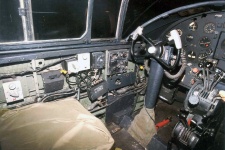 | This B-25B was likely to have had Bronze Green cockpits at the time of its construction. If this restoration color matches the original, it could be very close to the the very dark color chip. |
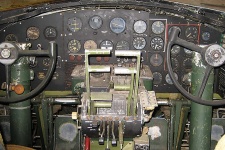 | This pre-restoration B-17G in the National Museum of the US Air Force shows a Bronze Green cockpit, with some sections retaining Green Zinc Chromate. This seems inconsistent with the time period (the B-17G was introduced in 1943) though orders may not have been immediately followed. |
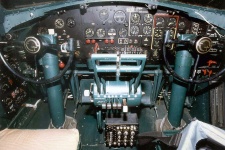 | Confusingly, another B-17G in the same museum shows the deeper blueish tint of Dull Dark Green. It is unclear whether this is the original color or has been changed during the restoration. |
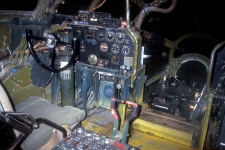 | Here's the cockpit of 'Bock's Car', a B-29 introduced in 1945 showing parts in Dull Dark Green below the instrument panel and on the control column, Interior Green sides, and some parts left in Zinc Chromate primer. |
| FED-STD | ANA | No. 41 | Munsell* | ||
| No. 25 | White | FS 37886 | ANA 601 | No. 46 | N9 |
| No. 26 | Sand | FS 31433 (?) | ANA 616 | No. 49 | 5YR 7/4 |
| No. 27 | Light Blue | FS 35466 (?) | - | - | 5B 7.6/4 |
| No. 28 | Sea Green | FS 34092 (?) | ANA 612 (!) | No. 42 (!) | 1G 2.8/3 |
| No. 29 | Dark Blue | FS 35109 | - | - | 4B 2.8/3 |
| No. 30 | Dark Green | FS 34077 (?) | - | - | 4G 2.4/1.8 |
| No. 31 | Dark Olive Drab | FS 34088 (?) | ANA 613 (!) | No. 41 | 8Y 3.6/3 |
| No. 32 | Neutral Gray | FS 36173 | ANA 603 (!) | No. 43 | N5 |
| No. 33 | Black | FS 37038 | ANA 604 | No. 44 | N2 |
| No. 34 | Rust Brown | FS 30117 | - | - | 5YR 3/4 |
* Munsell values were originally provided using 1929 notation. N values have been converted to Hex relative to greyscale range.
| FED-STD | ANA | 14057-C | Munsell | ||
| No. 41 | Dark Olive Drab | FS 34086 (?) | ANA 613 (!) | No. 31 | ? |
| No. 42 | Medium Green | FS 34092 | ANA 612 | No. 28 (!) | ? |
| No. 43 | Neutral Gray | FS 36173 | ANA 603 (!) | No. 32 | ? |
| No. 44 | Black | FS 37038 | ANA 604 | No. 33 | ? |
| No. 45 | Insignia Red | FS 31136 | ANA 619 | - | ? |
| No. 46 | Insignia White | FS 37886 | ANA 601 | No. 25 | ? |
| No. 47 | Insignia Blue | FS 35042 | ANA 605 | - | ? |
| No. 48 | Identification Yellow | FS 33538 | ANA 614 | - | ? |
| No. 49 | Sand | FS 30315 (?) | ANA 616 | No. 26 | ? |
| FED-STD | ANA | No. 41 | Munsell* | ||
| No. 302 | Earth Brown | FS 30099 | - | - | ? |
| No. 303 | Field Drab | FS 30118 | ANA 617 | - | ? |
| No. 305 | Earth Yellow | FS 30257 | - | - | ? |
| No. 306 | Sand | FS 33448 | - | - | 0.7Y 6.6/3.7 |
| No. 307 | Light Blue | FS 35190 (?) | - | - | ? |
| No. 312 | Earth Red | FS 30117 | - | - | ? |
| No. 319 | Olive Drab | FS 34088 | ANA 613 | No. 41 | ? |
| No. 321 | Light Green | FS 34258 | ANA 611 | - | ? |
* Hex values adapted from color plate in Archer & Archer (1976) modified to match No. 306 Sand Munsell value provided by Nick Millmann via Britmodeller.
| FED-STD | No. 41 | 14057-C | Munsell | ||
| ANA 601 | Insignia White | FS 37875 | No. 46 | No. 25 | 8.3Y 9.17/0.6 |
| ANA 602 | Light Gray | FS 36440 | - | - | 2.4GY 6.51/0.5 |
| ANA 603 | Sea Gray | FS 36118 | No. 43 (!) | No. 32 (!) | 3.7PB 3.94/0.96 |
| ANA 604 | Black | FS 37038 | No. 44 | No. 33 | 3.2PB 2.28/0.1 |
| ANA 605 | Insignia Blue | FS 35044 | No. 47 | - | 5.7PB 2.47/1.55 |
| ANA 606 | Semi-gloss Sea Blue | FS 25042 | - | - | 1.0PB 2.94/1.5 |
| ANA 607 | Non-spectacular Sea Blue | FS 35042 | - | - | 0.3PB 2.67/1.4 |
| ANA 608 | Intermediate Blue | FS 35164 | - | - | 0.3PB 4.86/2.45 |
| ANA 609 | Azure Blue | FS 35231 | - | - | 5.3PB 5.36/6.35 |
| ANA 610 | Sky | FS 34424 | - | - | ? |
| ANA 611 | Interior Green | FS 34151 | - | - | 3.3GY 4.55/3.6 |
| ANA 612 | Medium Green | FS 34092 | No. 42 | No. 28 (!) | 0.3G 3.57/1.85 |
| ANA 613 | Olive Drab | FS 33070 (?) | No. 41 (!) | No. 31 (!) | 7.0Y 3.62/1.5 |
| ANA 614 | Orange Yellow | FS 33538 | No. 48 | - | 0.5Y 7.16/11.0 |
| ANA 615 | Middle Stone | FS 30266 | - | - | ? |
| ANA 616 | Sand | FS 30279 | No. 49 | No. 26 | ? |
| ANA 617 | Dark Earth | FS 30118 | - | - | ? |
| ANA 618 | Dull Red | FS 30109 | - | - | 9.3R 3.71/5.5 |
| ANA 619 | Insignia Red | FS 31136 | No. 45 | - | 5.2R 4.16/10.65 |
| ANA 620* | Light Gull Gray | FS 36440 | - | - | 4.55GY 7.08/0.27 |
| ANA 621* | Dark Gull Gray | FS 36231 | - | - | 7.3B 5.36/0.5 |
| ANA 622* | Jet | FS 17038 | - | - | 0.8PB 0.68/0.5 |
| ANA 623* | Sea Blue | FS 15042 | - | - | 0.55PB 2.59/1.45 |
| ANA 625* | Sea Plane Gray | FS 26081 | - | - | ? |
| ANA 626* | Semi-gloss White | FS 27875 | - | - | ? |
| ANA 627* | Field Green | FS 34097 | - | - | ? |
| ANA 628* | Sierra Tan | FS 30219 | - | - | ? |
| ANA 631* | Forest Green | FS 34079 | - | - | ? |
| FED-STD | No. 41 | 14057-C | Munsell | ||
| ANA 501 | Light Blue | FS 15102 | - | - | 3.7PB 3.54/8.15 |
| ANA 502 | Insignia Blue | FS 15044 | - | - | 4.9PB 1.25/2.95 |
| ANA 503 | Light Green | FS 14187 | - | - | 8.5GY 4.67/8.15 |
| ANA 504 | Olive Drab | FS 24165 | - | - | 6.8Y 2.88/1.95 |
| ANA 505 | Light Yellow | FS 13655 | - | - | 5.4Y 7.74/11.8 |
| ANA 506 | Orange Yellow | FS 13538 | - | - | 1.2Y 7.3/13.05 |
| ANA 507 | Aircraft Cream | FS 13594 | - | - | ? |
| ANA 508 | International Orange | FS 12197 | - | - | 9.3R 4.49/13.7 |
| ANA 509 | Insignia Red | FS 11136 | - | - | 7.65R 3.13/11.5 |
| ANA 510 | Maroon | FS 10049 | - | - | 1.4YR 2.38/3.25 |
| ANA 511 | Insignia White | FS 17875 | - | - | 4.2GY 8.93/0.6 |
| ANA 512 | Aircraft Gray | FS 16473 | - | - | 2.4B 6.68/0.8 |
| ANA 513 | Engine Gray | FS 16081 | - | - | 2.7B 3.10/0.35 |
| ANA 514 | Instrument Black | FS 27038 | - | - | 2.4PB 2.30/0.4 |
| ANA 515 | Gloss Black | FS 17038 | - | - | 0.9PB 1.34/0.45 |
| ANA 516 | Strata Blue | FS 15045 | - | - | - |
Note: Where Munsell values are available, these have been converted to RGB/Hex values using Munsell Color Palette. All others taken from Cybermodeler.